When Style Meets Stone
An Award-Winning Partnership for an Artistic Duo
by Joel Davis
Photos by Richard Doyle
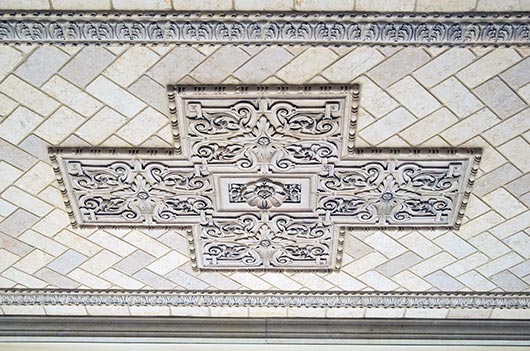 A strong foundation of historical inspiration and the artisan’s touch has brought the acknowledgment of a longtime collaboration between Michigan-based tile designer David Ellison and installer Richard Horne of RJH Tile, Stone, and Marble.
A strong foundation of historical inspiration and the artisan’s touch has brought the acknowledgment of a longtime collaboration between Michigan-based tile designer David Ellison and installer Richard Horne of RJH Tile, Stone, and Marble.
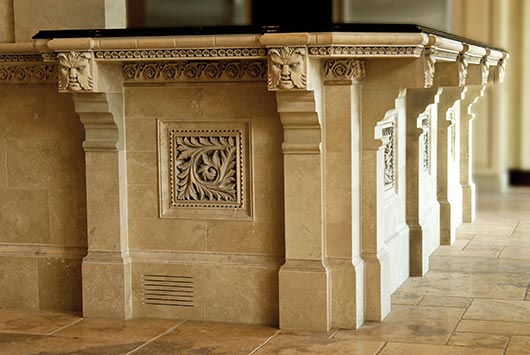 The duo’s informal, artistic partnership was honored during the Coverings Installation and Design Awards in June. They were honored for superior installation of tile or stone, overall aesthetics, and the interpretation of a distinctive design vision.
The duo’s informal, artistic partnership was honored during the Coverings Installation and Design Awards in June. They were honored for superior installation of tile or stone, overall aesthetics, and the interpretation of a distinctive design vision.
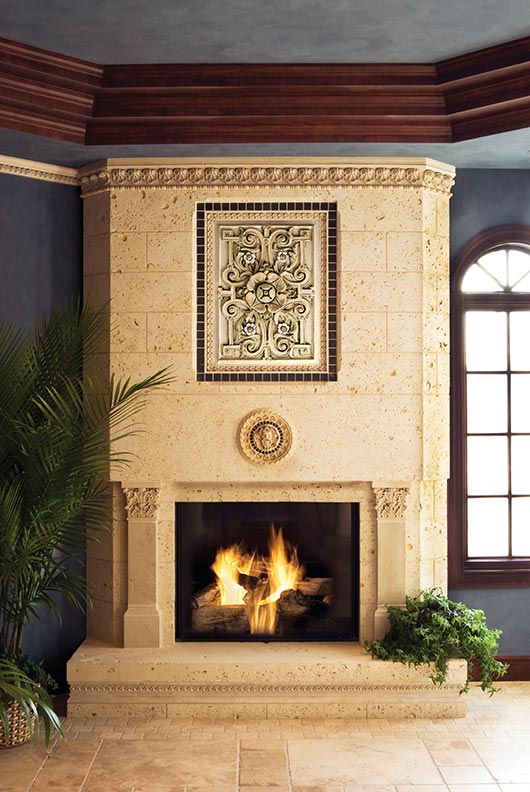 The pair were honored for their four-year-long collaboration on the 7,500-square-foot Rosenthal residence in Walled Lake, Mich. The project used a large amount of tile and stone throughout the home, including five bathrooms, the master bedroom, and a great room. Through use of special cuts, mitered installations, and epoxied finishes, stock stone was given a special appearance. Ellison produced hand-made, artisan tiles for the project.
The pair were honored for their four-year-long collaboration on the 7,500-square-foot Rosenthal residence in Walled Lake, Mich. The project used a large amount of tile and stone throughout the home, including five bathrooms, the master bedroom, and a great room. Through use of special cuts, mitered installations, and epoxied finishes, stock stone was given a special appearance. Ellison produced hand-made, artisan tiles for the project.
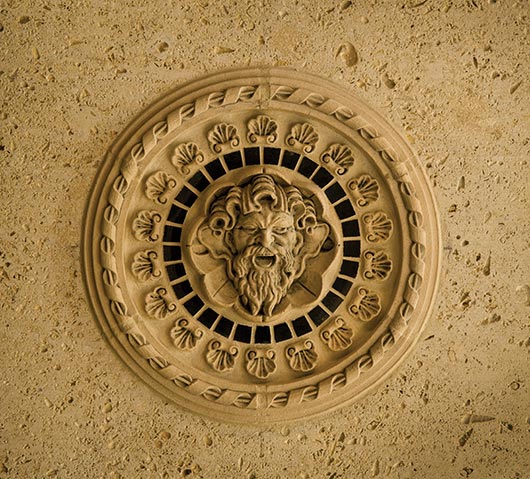 “We are very interested in doing special custom pieces,” Ellison said. “Richard would rather do something special than a mall floor even at a lower cost. We are not in it for the money. It is a passion.”
“We are very interested in doing special custom pieces,” Ellison said. “Richard would rather do something special than a mall floor even at a lower cost. We are not in it for the money. It is a passion.”
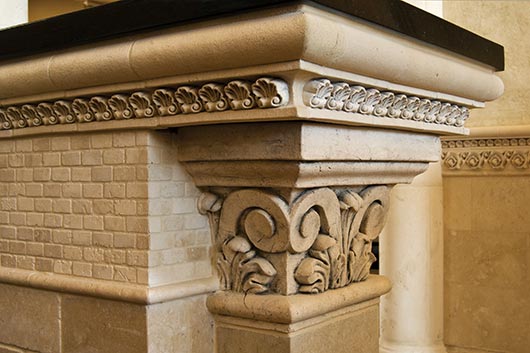 Ellison, who lives in St. Claire Shores, Mich., owns David Ellison Tile. Horne’s business, RJH Tile, Stone, and Marble in Holly, Michigan, specializes in stone, tile, and masonry work. “I’ve had my own business for 20 years now,” Horne said. “We are a custom installation crew. We do a lot of our own design work. Our specialty is custom stone installation of all kinds.”
Ellison, who lives in St. Claire Shores, Mich., owns David Ellison Tile. Horne’s business, RJH Tile, Stone, and Marble in Holly, Michigan, specializes in stone, tile, and masonry work. “I’ve had my own business for 20 years now,” Horne said. “We are a custom installation crew. We do a lot of our own design work. Our specialty is custom stone installation of all kinds.”
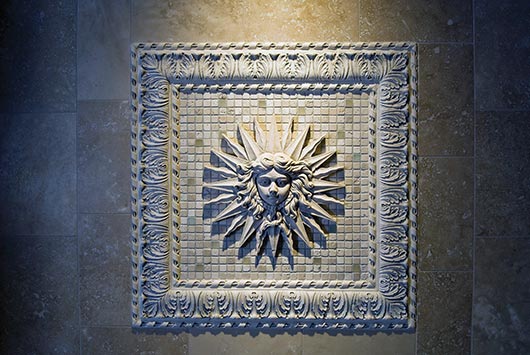 The pair first met years ago when Horne sent his wife down to Ellison’s business to look for tile to use in a bathroom renovation. They began collaborating and have worked on a variety of projects.
The pair first met years ago when Horne sent his wife down to Ellison’s business to look for tile to use in a bathroom renovation. They began collaborating and have worked on a variety of projects.
“We do some outside fountains and stone works, fireplaces, and backsplashes, primarily with high relief tile,” Ellison said. “Relative few ever go on the floor. It is mostly on walls.”
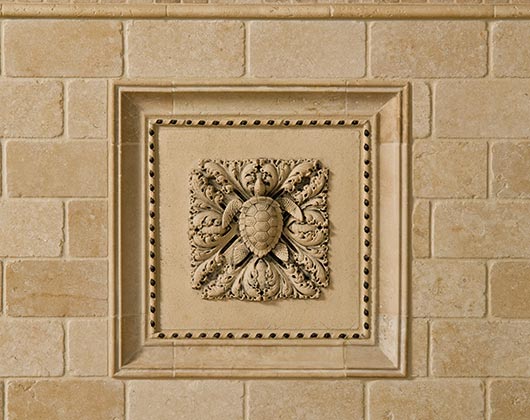 Fireplaces are an excellent project for the use for higher end artisan products because of their high visibility and relatively low surface area, Ellison said. “Even if you have an expensive product, you don’t have a lot of cover there.”
Fireplaces are an excellent project for the use for higher end artisan products because of their high visibility and relatively low surface area, Ellison said. “Even if you have an expensive product, you don’t have a lot of cover there.”
By the use of stock materials as the base of their designs, the pair can help customers get the most out of their budget by concentrating the use of artisan materials where they will make the most visual impact. “The basic material we use is tumbled stone,” Ellison said.
“By using it, we can cover 80 to 90 percent of the surface in a relatively affordable base product. I produce all the ornamentation and the decorative pieces to go with that.”
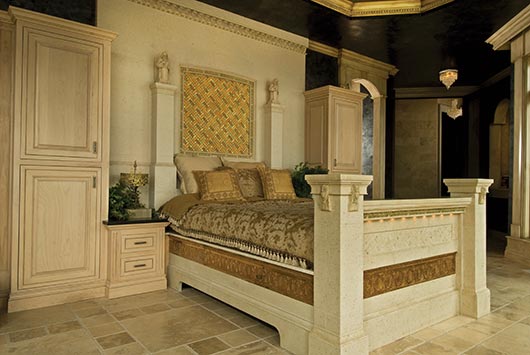 Working with Ellison allows RJH Tile and Marble access to a rich source of architectural tile. “We incorporate that with our stone work,” Horne said. “We are more or less a partnership without the partnership.”
Working with Ellison allows RJH Tile and Marble access to a rich source of architectural tile. “We incorporate that with our stone work,” Horne said. “We are more or less a partnership without the partnership.”
“I’m a designer,” said Ellison. “I make the tiles. He’s the installer. We both have the same passion. We just have different ways of coming to the product.”
The designs are developed on the computer and incorporated by hand-measuring, hand-drawing, and consulting with architectural references. Horne will then approach Ellison about producing a specific type of tile for the project. “A lot of the time what I’ll do is hand-draw something, and he works his magic and puts it together,” Horne said. “He’s very good at what he does.”
As an installer, Horne’s work is often based on historical architecture. His interest runs from the 12th Century onward. “The great cathedrals — anything to do with stone,” he said. “The older I get, that is really what I enjoy looking at it. I like to take it back as far as we can.”
Horne and his crew are all natives of Great Britain. Returning home for visits still serves to inspire him. “Every time I go back, I look at different structures, different cathedrals, and old houses,” he said. “You look at details of how stone masons used to be putting things together. It’s more or less a lost art form as time goes on.”
The tiles produced by Ellison feature finer detailed ornamentation than what people might normally associate with the product. “(What I do) is more like stone carving,” he said. “People have a preconceived notion of shiny glazes. Ours are unglazed and probably closer to stone than tile is traditionally thought of. They all have a historic nature to them like they’ve been around. They have had a history already.”
Ellison works from a small studio at his home. Producing tile is done by hand. “We make a porcelain model for a tile, and then we’ll make a plaster mold,” he said. “The clay is pressed into it. All the tiles are handmade. They are hand-pressed.”
“We have a variety of different styles,” Ellison said. “We are not necessarily a high volume production studio. We don’t stock tile. We make it as we need it. We have a very large library of patterns and ornamentation here.”
“I have got some historic patterns from old studios.”
Ellison’s journey in artisan tile began at the Pewabic Pottery in Detroit, Mich. Founded in 1903 by Mary Chase Perry and Horace Caulkins, developer of the portable Revelation Kiln.
The name of Pewabic Pottery is well-known in connection with the rise of the Arts and Crafts Movement in Detroit. “It was not as big as some of the really old companies but was still well respected,” Ellison said.
Michigan State University became the owner of the business in 1966 and operated the pottery as part of its continuing education program. As a student at Pewabic, Ellison was engaged in independent study for architectural ceramics.
When ownership was transferred from the university to the private, nonprofit Pewabic Society in 1981, work began to revitalize the Pewabic’s educational offerings, during which Ellison’s help was enlisted. As a Pewabic staff member, he set up the tile program. Later, after starting his own business, he returned to teach.
The experience gave him a strong foundation in the visual, structural, and architectural aspects of tile. The historical patterns associated with Pewabic served as a starting point for Ellison’s evolving aesthetics. “It was probably a little more naïve and primitive than what we had in mind. We wanted to go toward more of a European style.”